Development of a Multicolor 3D Printer Using a Novel Filament Shifting Mechanism
Abstract
:1. Introduction
2. General Concept of the Proposed Multicolor 3D Printer
3. Design of the Filament Shifting Device
3.1. Filament Feeding Transmission System
3.2. Filament Shifting Mechanism
- –
- S is the displacement of the pushing rod
- –
- d1 and d2 are the diameters of the two sections of the pushing rod
- –
- l21, l22, l23 are section length of the pushing rod
- –
- db is the diameter of the ball
- –
- S2 is the displacement of the ball
- –
- w1 is the width of the chamber of the spur gear
- –
- h1 is the height of the chamber of the spur gear
- –
- w2 is the thickness of the housing shaft wall
4. Development of Prototype and Experimental Results
5. Conclusions
Author Contributions
Funding
Institutional Review Board Statement
Informed Consent Statement
Data Availability Statement
Conflicts of Interest
References
- Medina-Sanchez, G.; Dorado-Vicente, R.; Torres-Jiménez, E.; López-García, R. Build Time Estimation for Fused Filament Fabrication via Average Printing Speed. Materials 2019, 12, 3982. [Google Scholar] [CrossRef] [Green Version]
- Ngo, T.D.; Kashani, A.; Imbalzano, G.; T.Q.Nguyen, K.; Hui, D. Additive manufacturing (3D printing): A review of materials, methods, applications and challenges. Compos. Part B Eng. 2018, 143, 172–196. [Google Scholar] [CrossRef]
- Singh, S.; Singh, G.; Prakash, C.; Ramakrishna, S. Current status and future directions of fused filament fabrication. J. Manuf. Processes 2020, 55, 288–306. [Google Scholar] [CrossRef]
- Silva, A.S.; da Silva Salvador, G.M.; Castro, S.V.F.; Carvalho, N.M.F.; Munoz, R.A.A. A 3D Printer Guide for the Development and Application of Electrochemical Cells and Devices. Front. Chem. 2021, 9, 684256. [Google Scholar] [CrossRef]
- Shen, H.; Liu, B.; Liu, S.; Fu, J. Five-Axis Freeform Surface Color Printing Technology Based on Offset Curve Path Planning Method. Appl. Sci. 2020, 10, 1716. [Google Scholar] [CrossRef] [Green Version]
- Jin, Z.; Li, Y.; Yu, K.; Liu, L.; Fu, J.; Yao, X.; Zhang, A.; He, Y. 3D printing of physical organ models: Recent developments and challenges. Adv. Sci. 2021, 8, 210139. [Google Scholar] [CrossRef]
- Ganguli, A.; Pagan-Diaz, G.J.; Grant, L.; Cvetkovic, C.; Bramlet, M.; Vozenilek, J.; Kesavadas, T.; Bashir, R. 3D printing for preoperative planning and surgical training: A review. Biomed. Microdevices 2018, 20, 65. [Google Scholar] [CrossRef]
- Ruiz, O.G.; Dhaher, Y. Multi-color and Multi-Material 3D Printing of Knee Joint models. 3D Print. Med. 2021, 7, 12. [Google Scholar] [CrossRef]
- Arefin, A.M.E.; Khatri, N.R.; Kulkarni, N.; Egan, P.F. Polymer 3D Printing Review: Materials, Process, and Design Strategies for Medical Applications. Polymers 2021, 13, 1499. [Google Scholar] [CrossRef]
- Ye, Z.; Dun, A.; Jiang, H.; Nie, C.; Zhao, S.; Wang, T.; Zhai, J. The role of 3D printed models in the teaching of human anatomy: A systematic review and meta-analysis. BMC Med. Educ. 2020, 20, 335. [Google Scholar] [CrossRef]
- Kholyia, R. 3D printing: The Face of Future Fashion. Int. J. Recent Res. Asp. 2016, 3, 80–85. [Google Scholar]
- Jeong, J.; Park, H.; Lee, Y.; Kang, J.; Chun, J. Developing parametric design fashion products using 3D printing technology. Fash. Text. 2021, 8, 22. [Google Scholar] [CrossRef]
- 3ders. Intricate, Multi-Color & Multi-Material Italian Fashion Pieces Created with 3D Printer in Hours. Available online: https://www.3ders.org/articles/20150306-intricate-multi-color-material-italian-fashion-pieces-created-with-3d-printer-in-hours.html (accessed on 12 March 2022).
- Menano, L.; Fidalgo, P.; Santos, J.M.; Thormann, J. Integration of 3D Printing in Art Education: A Multidisciplinary Approach. Comput. Sch. 2019, 36, 222–236. [Google Scholar] [CrossRef]
- Short, D.B. Use of 3D Printing by Museums: Educational Exhibits, Artifact Education, and Artifact Restoration. 3D Print. Addit. Manuf. 2015, 2, 209–215. [Google Scholar] [CrossRef]
- Chen, G.; Chen, C.; Yu, Z.; Yin, H.; He, L.; Yuan, J. Color 3D Printing: Theory, Method, and Application. New Trends 3D Print. 2016. [Google Scholar] [CrossRef] [Green Version]
- Boulaala, M.; Elmessaoudi, D.; Buj, I.; el Mesbahi, J.; Mazighe, M.; Astito, A.; El Mrabet, M.; Elmesbahi, A. Reviews of Mechanical Design and Electronic Control of Multi-material/Color FDM 3D Printing. In Advances in Integrated Design and Production (CPI 2019), Lecture Notes in Mechanical Engineering; Springer: Cham, Switzerland, 2020. [Google Scholar]
- Da Vinci Color 3D Printer. Available online: https://www.xyzprinting.com/en-US/product/da-vinci-color (accessed on 26 March 2022).
- Li, Z.; Li, Z.; Shao, L.; Han, S. Experimental investigation using vibration testing method to optimize feed parameters of color mixing nozzle for fused deposition modeling color 3D printer. Adv. Mech. Eng. 2019, 11, 1687814019896196. [Google Scholar] [CrossRef]
- Zonestar 3D Printer Manufacturer. Available online: http://www.zonestar3d.com/pd.jsp?id=129#_pp=103_523 (accessed on 26 March 2022).
- ORD Solutions. Available online: https://www.ordsolutions.com/ (accessed on 14 March 2022).
- Baca, D.; Ahmad, R. The impact on the mechanical properties of multi-material polymers fabricated with a single mixing nozzle and multi-nozzle systems via fused deposition modeling. Int. J. Adv. Manuf. Technol. 2020, 106, 4509–4520. [Google Scholar] [CrossRef]
- 3D Printer and 3D Printing News. D3D Kickstarter Slimmer Extruder Upgrade. Available online: https://www.3ders.org/articles/20140217-d3d-kickstarter-slimmer-extruder-upgrade.html (accessed on 14 March 2022).
- All3DP. First Look at the Prometheus System. Available online: https://all3dp.com/prometheus-system/ (accessed on 26 March 2022).
- Ali, M.H.; Mir-Nasiri, N.; Ko, W.L. Multi-Nozzle Extrusion System for 3D Printer and its Control Mechanism. Int. J. Adv. Manuf. Technol. 2015, 86, 999–1010. [Google Scholar] [CrossRef]
- Co Print 3D Printing Technologies. Available online: https://coprint3d.com/ (accessed on 26 March 2022).
- Yuk, H.; Lu, B.; Lin, S.; Qu, K.; Xu, J.; Luo, J.; Zhao, X. 3D printing of conducting polymers. Nat. Commun. 2020, 11, 1604. [Google Scholar] [CrossRef] [Green Version]
- Dickson, A.N.; Abourayana, H.M.; Dowling, D.P. 3D Printing of Fibre-Reinforced Thermoplastic Composites Using Fused Filament Fabrication—A Review. Polymers 2020, 12, 2188. [Google Scholar] [CrossRef]
- Tao, Y.; Kong, F.; Li, Z.; Zhang, J.; Zhao, X.; Yin, Q.; Xing, D.; Li, P. A review on voids of 3D printed parts by fused filament fabrication. J. Mater. Res. Technol. 2021, 15, 4860–4879. [Google Scholar] [CrossRef]
- Msallem, B.; Sharma, N.; Cao, S.; Halbeisen, F.S.; Zeilhofer, H.-F.; Thieringer, F.M. Evaluation of the Dimensional Accuracy of 3D-Printed Anatomical Mandibular Models Using FFF, SLA, SLS, MJ, and BJ Printing Technology. J. Clin. Med. 2020, 9, 817. [Google Scholar] [CrossRef] [PubMed] [Green Version]
- Kassim., S.; Ibrahim, M.; Sa’ude, N. Dimensional Accuracy Analysis for Desktop 3D Printers for Fused Deposition Modeling. In Proceedings of the Academics World 62nd International Conference, Seoul, Korea, 18–19 April 2017; pp. 7–10. [Google Scholar]
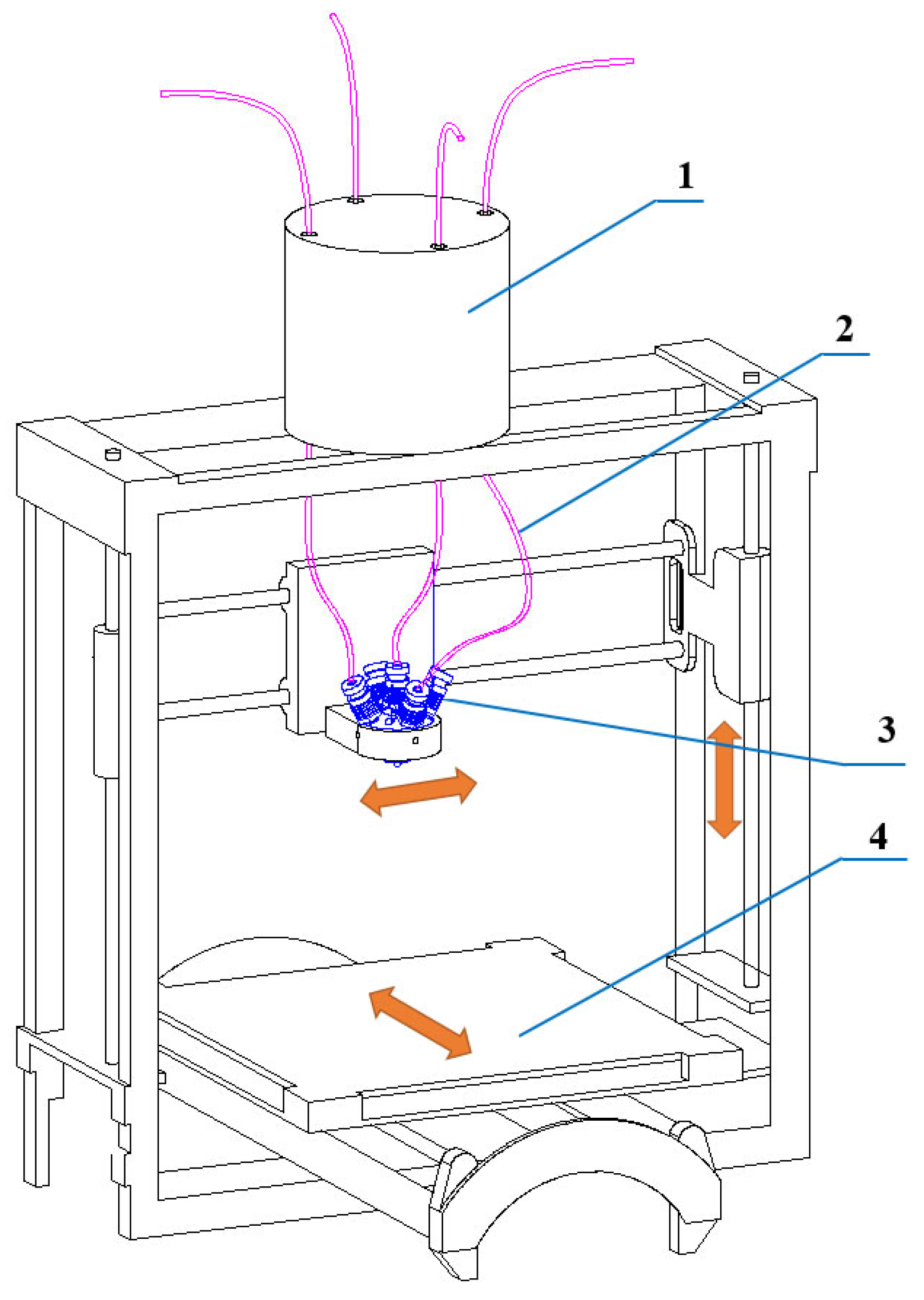

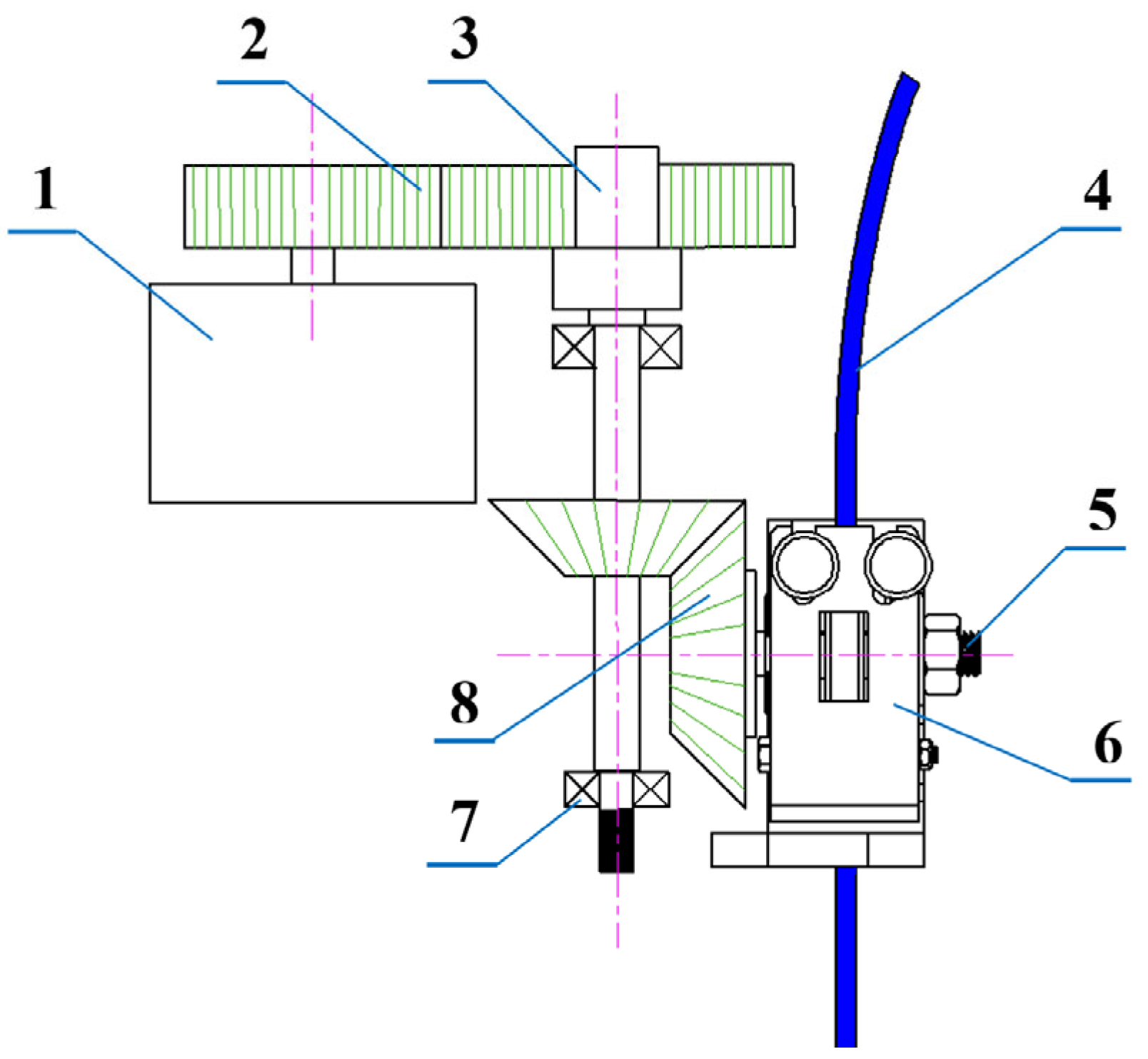
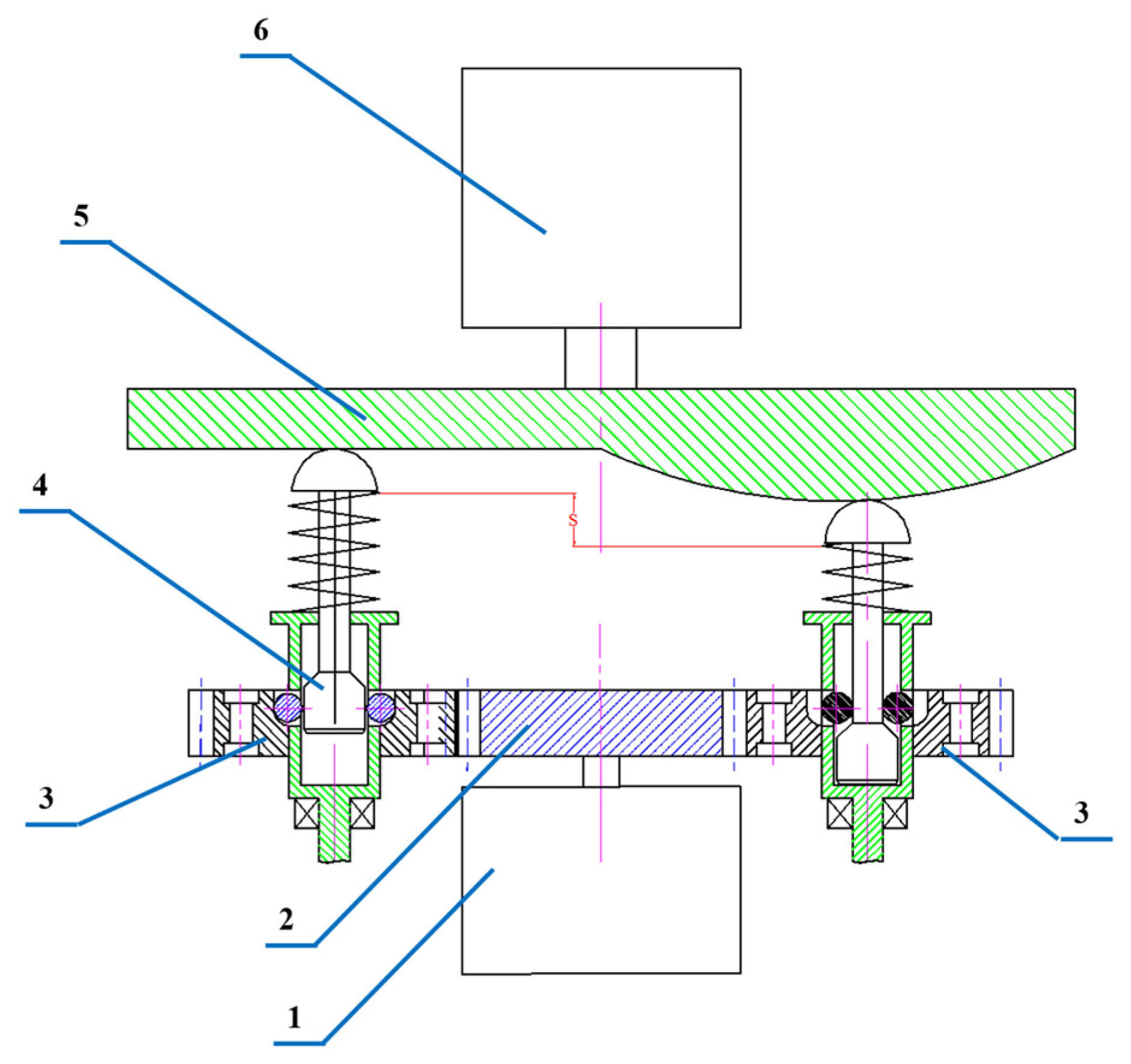
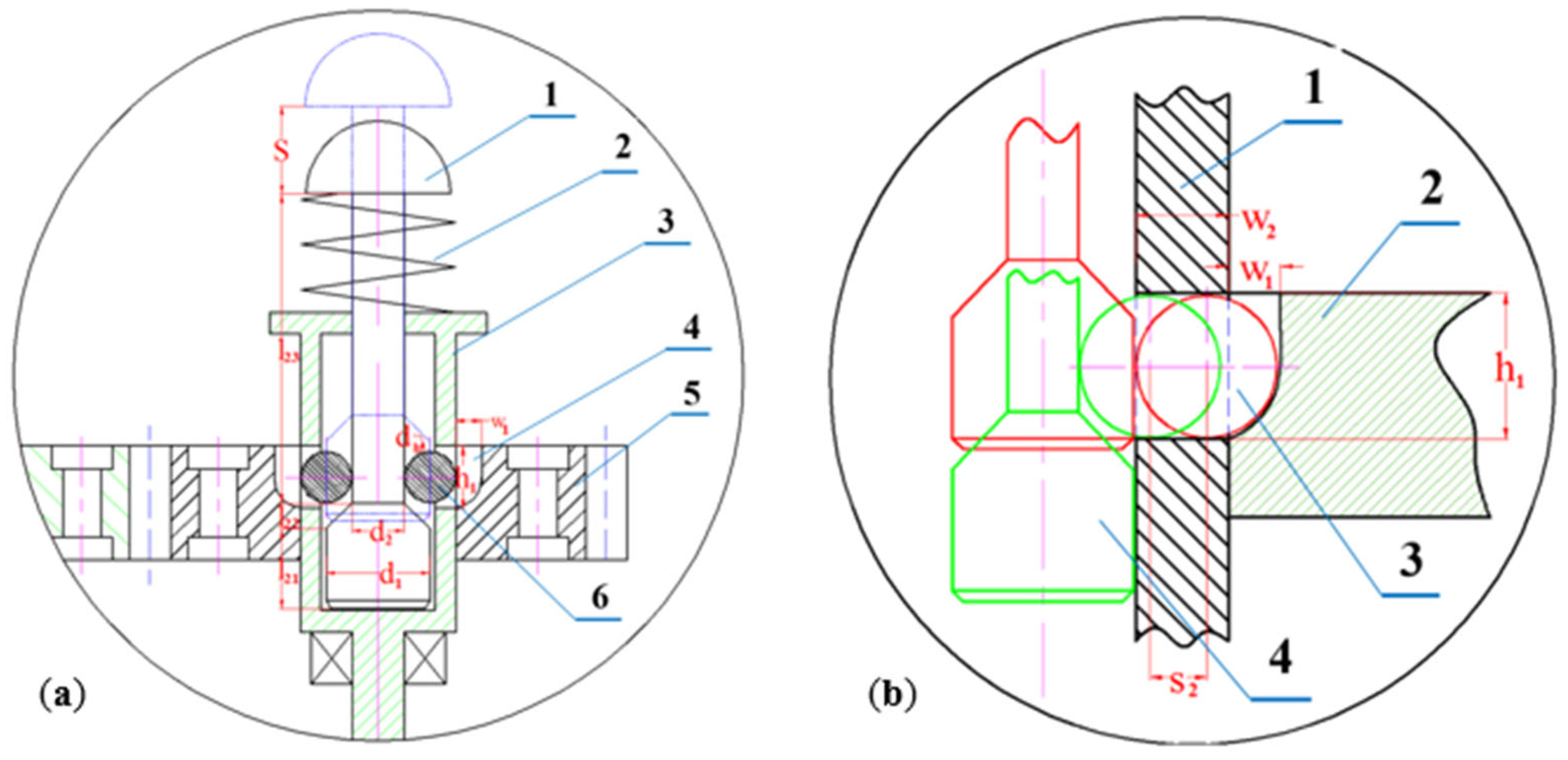
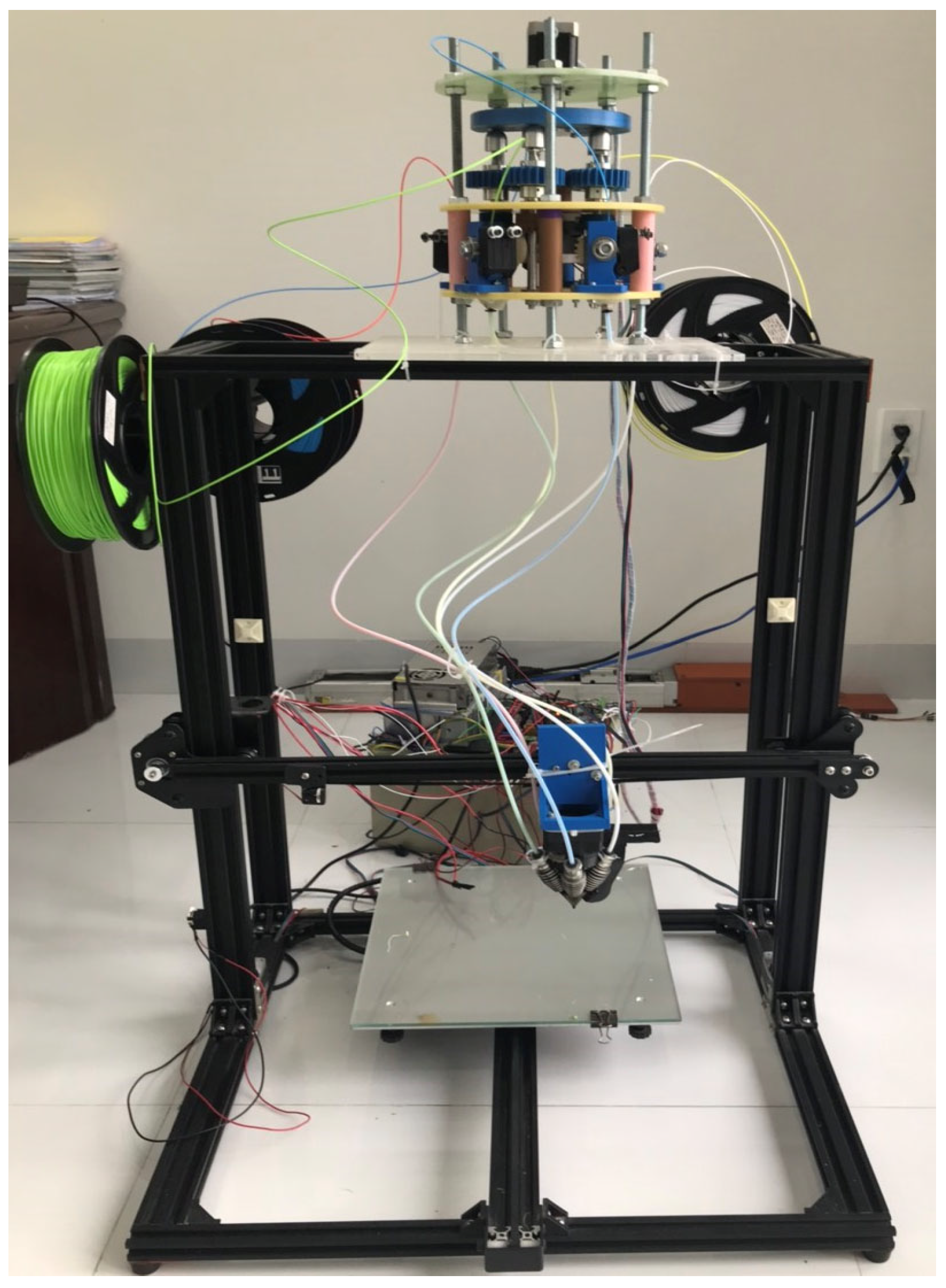

| Concept | Name of 3D Printer or Device | Manufacturer (Country) | Open-Source |
|---|---|---|---|
| Colored filament | Palette Filament Splicer [17] | Mosaic manufacturing company (Canada) | No |
| Da Vinci Color 3D printer [18] | XYZprinting, New Kinpo Group (Taiwan) | No | |
| Color mixing | Prusa 3D printer using Diamond Hotend [19] | Reprap.me (Denmark) | Yes |
| Z9V5 3D printer using 4-in-1-out hot-end | Shenzhen Zonestar Innovation Technology Co., Ltd. (China) | No | |
| Tronxy X5SA PRO printer with Tronxy 3 in 1 out Multi-color Extruder hot end [20] | Shenzhen Tronxy Technology Co., Ltd. (China) | No | |
| Multiple extruders | Multi-Color RoVa3D printer [21] | ORD Solution Company | No |
| BIBO 2 Extruders 3D Printer | Bibo Automatic Equipment Co., Ltd. (China) | No | |
| Geeetech I3 pro C dual extruder 3D printer | HK Getech Co., Ltd. (China) | No | |
| Disco Ultimate 3D printer | Dagoma (France) | No | |
| Creator Pro | Flashforge (China) | No | |
| Filament/nozzle switching | D3D filament shifter [23] | DGlass3D Company | No |
| Prometheus System [24] | Eric Sammut-DisTech Automation (Canada) | Yes | |
| Multi-nozzle extrusion system [25] | Md Hazrat Ali, Mir-Nasiri Nazim (Kazakhstan), and Ko Wai Lun (Hong Kong) | No | |
| Co Print 3D Multi-Filament Module [26] | Co Print 3D Printer Technologies, England | No |
| Geometry | Nature | Reference | Measured Error (%) | Average | ||||
|---|---|---|---|---|---|---|---|---|
| Square | Edge | 40 mm | 0.63 | 0.70 | 0.43 | 0.38 | 0.15 | 0.5 |
| 0.70 | 0.68 | 0.75 | 0.28 | 0.28 | ||||
| Circular ring | Inner Ø | 20 mm | 0.28 | 1.50 | 0.50 | 0.83 | 0.53 | 0.73 |
| Outer Ø | 40 mm | 3.75 | 3.70 | 1.50 | 1.10 | 3.35 | 2.68 | |
| Triangle | Edge | 40 mm | 0.30 | 0.60 | 0.50 | 0.35 | 0.90 | 0.50 |
| 0.23 | 0.83 | 0.43 | 0.55 | 0.90 | ||||
| 0.38 | 0.60 | 0.35 | 0.10 | 0.63 | ||||
| Ellipse | Major axis | 50 mm | 0.18 | 0.40 | 0.26 | 0.30 | 0.00 | 0.23 |
| Minor axis | 30 mm | 0.53 | 0.30 | 0.37 | 0.33 | 0.57 | 0.42 | |
Publisher’s Note: MDPI stays neutral with regard to jurisdictional claims in published maps and institutional affiliations. |
© 2022 by the authors. Licensee MDPI, Basel, Switzerland. This article is an open access article distributed under the terms and conditions of the Creative Commons Attribution (CC BY) license (https://creativecommons.org/licenses/by/4.0/).
Share and Cite
Thi Hai, V.N.; Phu, S.N.; Essomba, T.; Lai, J.-Y. Development of a Multicolor 3D Printer Using a Novel Filament Shifting Mechanism. Inventions 2022, 7, 34. https://doi.org/10.3390/inventions7020034
Thi Hai VN, Phu SN, Essomba T, Lai J-Y. Development of a Multicolor 3D Printer Using a Novel Filament Shifting Mechanism. Inventions. 2022; 7(2):34. https://doi.org/10.3390/inventions7020034
Chicago/Turabian StyleThi Hai, Van Nguyen, Sinh Nguyen Phu, Terence Essomba, and Jiing-Yih Lai. 2022. "Development of a Multicolor 3D Printer Using a Novel Filament Shifting Mechanism" Inventions 7, no. 2: 34. https://doi.org/10.3390/inventions7020034
APA StyleThi Hai, V. N., Phu, S. N., Essomba, T., & Lai, J.-Y. (2022). Development of a Multicolor 3D Printer Using a Novel Filament Shifting Mechanism. Inventions, 7(2), 34. https://doi.org/10.3390/inventions7020034






